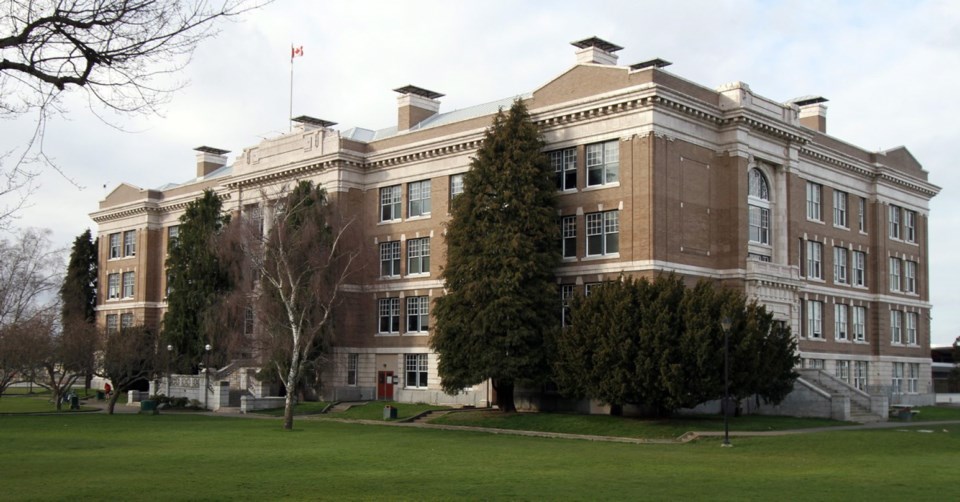Victoria High School, the oldest public secondary school in western Canada, is getting a seismic upgrade and a 200-seat expansion with the announcement of $77.1 million in funding from the province.
Vic High dates to 1876 and has been at its current Fernwood site since 1914.
Work is scheduled to begin in August 2020 and be completed by September 2022.
After a performance by the Vic High R&B Band to mark the occasion in the school auditorium on the last day of classes, Education Minister Rob Fleming said the provincial money for Vic High follows promises for funding from previous governments going back years. The Greater Victoria School District is contributing $2.6 million.
“It is long overdue,” Fleming said. “This community deserves it, and soon Vic High students I’m proud to say will be learning inside a safe school with more space to take full advantage of our new curriculum in British Columbia.
“This investment means that this school will be standing tall for years and decades to come.”
Preservation of Vic High’s facade is a key part of the plans.
The former S.J. Willis Education Centre on Topaz Avenue will serve as “swing” space for Vic High students needing to relocate during construction activity.
Grade 9 student Talia Collins told the auditorium crowd that she is looking forward to the future of the school. “I’m honoured to be part of the Vic High legacy,” she said. “The students at Victoria High School are so excited to be given direction on the next steps for our iconic building. With our move to S.J. it will be hard, but returning to our new, improved school will be wonderful.”
Fleming stressed Vic High’s connection to Canada’s war efforts and the contribution Vic High students made on D-Day, which had its 75th anniversary marked this month. Students joined the Allied effort to liberate Europe, he noted.
Fleming touted the inclusion of a neighbourhood learning centre at the revamped Vic High. “[It’s] community space and the priority for that community space is much-needed childcare spaces,” he said. “So the wait list that we have among young parents who can’t afford to go back to work, can’t get into childcare spaces … is going to be addressed.”
Also included in the project will be renewal of the “sports infrastructure” at the school.
“Because once upon a time Vic High was the powerhouse school in sports,” Fleming said.
The school has a crumbling running-track area, but it is unclear how that will fit into the plans.
Greater Victoria school board chairwoman Jordan Watters said she is grateful for the Vic High news. “We have been planning and dreaming this for years and truly I know the Vic High community has been hoping for this for well over a decade,” she said. “So the day has arrived where we are excitedly getting ready to build a new Vic High that maintains the heritage of this important building in our community.”
Extensive public consultation by the school district emphasized how much Vic High means to people, Watters said.
She said the building that emerges will serve students for another century. “Victoria High School’s reached capacity and so we’re seeing that continuous upward trajectory,” she said. “An extra 200 spaces will make a huge difference in the learning conditions for our students and for our staff.”
There are currently about 800 spaces at the school.
Vic High Alumni Association member Ian McKinnon said the funding for the project serves both students and the school’s special heritage. “We look forward with optimism to a future for Vic High that continues to offer its students the greatest opportunities while honouring the history of this school and its importance to the province and our city.”
Acting Victoria Mayor Laurel Collins said the city supports the project, which she said will be providing services to residents to places such as an affordable-housing project planned for Fernwood.
“This is what builds strong communities,” she said.
The planning phase for the Vic High project included considerable discussion about which construction option should be favoured. Also looked at were an option of about $67 million that would have involved demolition and an entirely new school, and a $61-million option that would have seen the school remain at an 800-student capacity.



